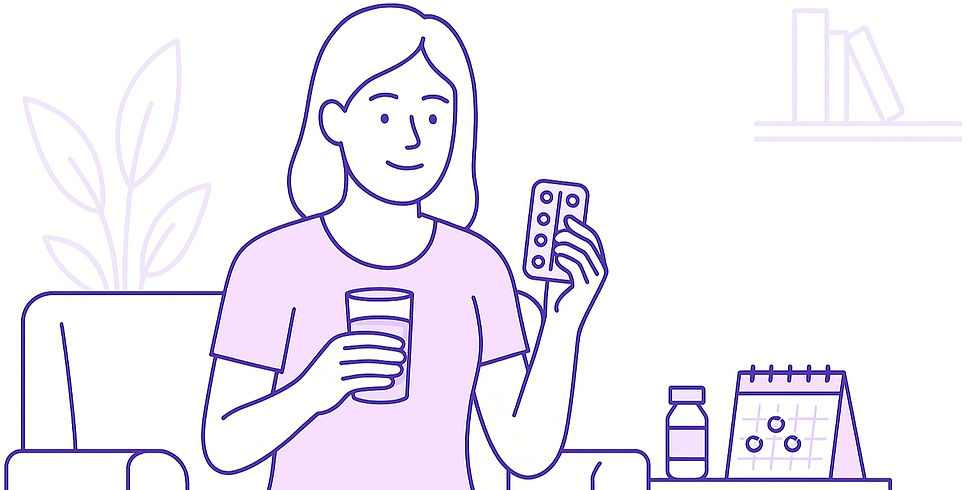How Does Ovulation Induction Work? Protocols, Medicine, Steps, and More
- AMALSHA S
- Aug 26
- 4 min read
Updated: Oct 21

Every female ovulates, but not all of them ovulate regularly. Here comes 'Ovulation induction' to rescue.
When your ovaries aren't releasing mature eggs as required for pregnancy, a gentle stimulation can balance that process. It is one of the first steps that doctors suggest if you are dealing with fertility challenges.
Ovulation induction isn't the same for every female. The protocol can change based on one's age, medical history, and underlying condition. For example, if a woman has PCOS, Metformin can act as a stimulator. But if infertility is unexplained, another medical approach may be required.
What is Ovulation Induction?
Ovulation induction is a simple medical treatment where specific hormone-stimulating medicines encourage the ovaries to release eggs.
Naturally, most females produce one egg during each menstrual cycle. Some even produce multiple eggs, increasing the chances of twins or more offspring. However, some women may not experience ovulation regularly, which hinders their chance of pregnancy.
In case of irregular or no ovulation, an Ovulation induction turns out to be the most favourable fertility treatment. It stimulates egg release, creates predictable cycles, and improves the chances of conceiving. During this process, doctors can even increase the number of eggs per release.
Ovulation induction alone cannot help without timed intercourse or intrauterine insemination (IUI).
Ovulation Induction Protocols & Medicines

Ovulation induction is a simple process, but varied with a choice of protocols. Your approach can vary with age, health, and response to the medicines. Every protocol involves a different drug aiming to stimulate the ovaries in its own specific way.
Aim? To have safe egg development while reducing the complications of overstimulation or multiple pregnancies.
Now let’ s move to the details;
Clomiphene Citrate Protocol: It is usually the first and most basic medicine used in Ovulation induction. Clomiphene stimulates female hormones in the brain, which trigger the ovaries to release eggs. Doctors prescribe these tablets for five days early in the cycle. It is effective for females dealing with irregular periods.
Letrozole or Metformin Protocol: These are another oral tablet widely used for ovarian stimulation amongst females struggling with polycystic ovary syndrome (PCOS). Letrozole lowers estrogen levels (temporarily) and encourages the female body to release hormones that stimulate egg growth. For PCOS patients, Metformin works by decreasing insulin resistance. Most women respond well to these options with fewer side effects than Clomiphene.
Gonadotropins Protocol: These are injectable hormones that directly stimulate the ovaries, unlike the oral tablets discussed above. Gonadotropins are stronger in nature and demand regular ultrasound monitoring. It is an advanced protocol recommended for those who didn't benefit from oral medicines.
Combined/Step-Up Protocols: In cases where none of the above protocols (alone) help, doctors may combine them. A course of oral medicines with injections and gradually increased dosage makes the ovaries respond faster.
Tip: Ovulation medicines require careful monitoring. Do not start them without an expert consultation.
Who/Why is Ovulation Induction Recommended?
Anyway, doctors recommend Ovulation induction for:
Women dealing with irregular/ unpredictable ovulation cycles. Females struggling with PCOS or PCOD.
If your infertility is unexplained or yet to be medically diagnosed.
If the male partner is experiencing low sperm count, ovulation induction is timed with IUI for better chances.
To improve the availability of eggs before starting IVF, IUI, or other similar treatments.
Ovulation Induction Procedure: Step-by-Step

Ovulation induction is a simple process, but success only comes after careful planning and monitoring:
It begins with an initial medical consultation and evaluation to understand the reason for infertility.
Based on the diagnosis, the doctor will prescribe tablets or injections.
The following step involves hormone tests and ultrasound scans during the cycle. These are necessary to check egg growth and avoid overstimulation.
Once the egg is ready, a trigger shot is given to release it.
Further, to make sure the couple conceives, the doctor would tell them to plan intimacy during the peak fertility period. Or in some cases, an intrauterine insemination (IUI) is scheduled.
Lastly, a blood test after two weeks confirms if pregnancy has occurred.
“We struggled for 4 years with no success, moving from one doctor to another. But when my husband and I reached out to Bliss Fertility, everything changed.
What makes Bliss Fertility different is that it doesn't feel like a hospital, as the incredibly supportive and caring staff made all the difference. The treatment gave us confidence and comfort throughout the IVF process.
Eight months after our visit to Bliss, we welcomed two healthy and beautiful twin babies”.
Are There Any Side Effects of Ovulation Induction?
No, usually ovulation induction doesn’t have any side effects. However, like any hormone-stimulating medicine, some protocols may cause bloating, mood swings, hot flashes, and headaches.
Some women also feel slight pain or discomfort in the pelvic area due to enlarged ovaries.
The risk of ovarian hyperstimulation syndrome (OHSS) is also there, but it is less common. OHSS can cause pain, swelling, or fluid buildup. Or, multiple pregnancies (twins or more) are possible, carrying their own complications. That is why close monitoring is non-negotiable.
Pregnancy Success Rate with Ovulation induction
Generally, the pregnancy success rate with ovulation induction comes around 20%–25%. It fits closely with natural conception rates. But over several cycles (likely 5-6), the success rate can compound to 80%.
Letrozole gives 20% to 45% results, whereas clomiphene gives 15% to 20% results.
Key Takeaways:
Overall, ovulation induction can be your hope for becoming a parent. Yes, it isn’t a magical solution for infertility. Getting the right treatment and working under the best fertility specialist at Bliss Fertility will make all the difference. Call Now
+91 62 62 62 32 62 (Kottayam & Maldives)
+91 88 22 55 66 33 (Tirur)
+91 99 47 70 00 06 (Trivandrum)